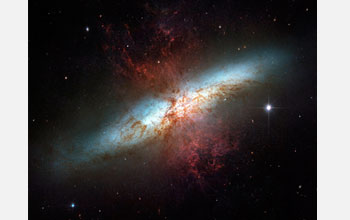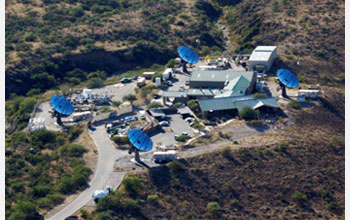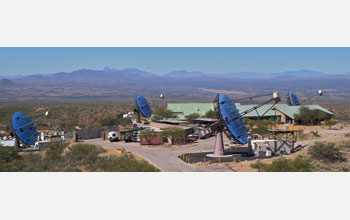All Images
News Release 09-212
VERITAS Discovers Very High Energy Gamma Rays from the Starburst Galaxy M82
Gamma-ray source identified for the first time, leading to better understanding of the early universe
This material is available primarily for archival purposes. Telephone numbers or other contact information may be out of date; please see current contact information at media contacts.

M82 is a bright galaxy located approximately 12 million light years from Earth, in the
direction of the Ursa Major constellation. In the active starburst region at its center, stars
are being formed at a rate approximately ten times more rapidly than in entire "normal" galaxies like our own Milky Way. The cosmic rays produced in the formation, life and death of the massive stars in this region eventually produce diffuse gamma-ray emission via their interactions with interstellar gas and radiation. Due to its unusually high cosmic-ray and gas densities and its relative proximity, M82 is expected to be the brightest starburst galaxy in VHE gamma rays.
Credit: NASA, ESA, and The Hubble Heritage Team (STScI/AURA)
Download the high-resolution JPG version of the image. (102 KB)
Use your mouse to right-click (Mac users may need to Ctrl-click) the link above and choose the option that will save the file or target to your computer.

The VERITAS (Very Energetic Radiation Imaging Telescope Array System) is a collection of four 12-meter Cherenkov telescopes used to detect astrophysical sources of very-high-energy gamma rays. VERITAS continues the tradition of the 10-m telescope and is also located at the Fred Lawrence Whipple Observatory (FLWO). It is comprised of an array of four 12-meter (39 feet) diameter Cherenkov telescopes. VERITAS began full-scale observations in September 2007. The telescopes are used to study the remnants of exploded stars, distant galaxies, powerful gamma ray bursts, and to search for evidence of mysterious dark matter particles.
Credit: N. Galante
Download the high-resolution JPG version of the image. (121 KB)
Use your mouse to right-click (Mac users may need to Ctrl-click) the link above and choose the option that will save the file or target to your computer.

The false-color figure taken from the study "A connection between star formation activity
and cosmic rays in the starburst galaxy M82," shows the very high energy gamma-ray
emission observed by VERITAS. The black star is the location of the active starburst
region. The emission from M82 is effectively point-like for VERITAS and the white circle
indicates the size of a simulated point-source. The entire galaxy would be contained
within the circle.
Credit: VERITAS
Download the high-resolution JPG version of the image. (159 KB)
Use your mouse to right-click (Mac users may need to Ctrl-click) the link above and choose the option that will save the file or target to your computer.

VERITAS, is operated by a collaboration of more than 100 scientists from 22 different
institutions in the United States, Ireland, England and Canada. VERITAS is funded by
the U.S. Department of Energy, the U.S. National Science Foundation, the Smithsonian
Institution, the Natural Sciences and Engineering Research Council of Canada, the
Science Foundation Ireland and the STFC of the U.K.
Credit: VERITAS
Download the high-resolution JPG version of the image. (473 KB)
Use your mouse to right-click (Mac users may need to Ctrl-click) the link above and choose the option that will save the file or target to your computer.


